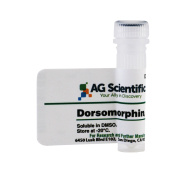When it comes to emerging fields of science, such as mechanobiology (the study of structural biology), having access to the newest biochemical reagents may be crucial part of your expermintal design. That's why one of the main services AG Scientific brings to the table is not only the latest in scientific research, but the latest in biochemical reagants, as well.
When it comes to emerging fields of science, such as mechanobiology (the study of structural biology), having access to the newest biochemical reagents may be crucial part of your expermintal design. That's why one of the main services AG Scientific brings to the table is not only the latest in scientific research, but the latest in biochemical reagants, as well.
A decade of hard work by researchers is finally translating into new biochemical tools that can assist researchers in their daily work. One such reagent showing promising results is dorsomorphin. Studies show dorsomorphin (10 mg/kg) blocks the production of hepcidin in adult mice, which in response serum iron concentrations in blood increase [1]. Dorsomorphin works by inhibiting BMP (bone morphogenic protein) type 1 receptors ALK2, ALK3 and ALK6 and thus blocks BMP-mediated downstream SMAD1/5/8 phosphorylation [1]. BMP signaling coordinates early developmental patterning and continues to play an essential role in the physiology of adult organisms [1].
By mapping cell fates and using gene knockout techniques, it was discovered that the main gene responsible for dorsal fate differentiation is Dorsalin-1 [2]. When Dorsalin-1 is expressed, the BMP (bone morphogenic protein) and TGF-b signaling pathways begin to spatially position the epithelial-to-mesenchymal transition (EMT). During embryonic development, this is officially when gastrulation begins, a dramatic process where the endoderm and mesoderm shift from the outer surface of the embryo to the inside where they will later develop into the internal organs [2]. All these actions work together to ensure the dorsal region is able to counter-act the force of resistance caused from growth in the opposite ventral region [2].
Dorsomorphin effective against anemia
Exposure to dorsomorphin in laboratory animals inhibits hepcidin expression [3]. In return for stimulating iron from the RES, erythropoiesis begins and the symptoms of anemia diminish. According to other leading researchers, hepcidin lowering agents, such as dorsomorphin, represent a promising new class of pharmacologic drugs, which may help patients effectively recover from anemia.
The hard fact is that anemia of chronic inflammation (ACI) is the most frequent case of anemia reported in hospitals, and it is associated with high morbidity [3].
The Royal Society of Chemistry concluded in 2011, A major underlying mechanism of ACI is the retention of iron within cells of the reticuloendothelial system (RES), thus making the metal unavailable for efficient erythropoiesis. This reticuloendothelial iron sequestration is primarily mediated by excess levels of the iron regulatory peptide hepcidin down-regulating the functional expression of the only known cellular iron export protein ferroportin resulting in blockade of iron egress from these cells. Using a well-established rat model of ACI, we herein provide novel evidence for effective treatment of ACI by blocking endogenous hepcidin production using the small molecule dorsomorphin derivative LDN-193189 or the protein soluble hemojuvelin-Fc (HJV.Fc) to inhibit bone morphogenetic protein-Smad mediated signaling required for effective hepcidin transcription. [3]
Less is known about its effects in humans, but phase 1 clinical trial (NCT01251562) have already begun [4]. For more information go to: Clinicaltrials.gov
Dorsomorphin when used in combination with SB431542
Dorsomorphin promotes human embryonic stem cell self-renewal by decreasing BMP signaling. New evidence is emerging that dorsomorphin and SB431542, when used in combination with the other, can disrupt the normal developmental programming of an embryo to induce neural differentiation [5]. According to The Royal Society of Chemistry, dorsomorphin and SB431542 are both classified among a group of other small molecules, “involved in promoting self-renewal, maintenance of the pluripotent state or other mechanisms that could improve reprogramming efficiency. [3]
By itself, SB431542 increases reprogramming in mouse fibroblasts, and has also been shown to generate iPSCs from human skeletal myoblasts [5].
Additional information about SB431542:
SB431542 is 100-fold more selective for ALK5 than p38 MAPK and other kinases [6].
SB431542 increased reprogramming in mouse fibroblasts transduced with Klf4, OCT4 and c-MYC genes [6].
SB431542 can induce the differentiation of human ESCs and iPSCs to neural lineages [6].
Other examples of small molecules that are considered effective inhibitors of the TGF signaling pathway are SB431542, RepSox, and A-83-01, and all can be useful at reprogramming stem cells [5].
During early embryogenesis, these positioning signals produce mesenchymal stem cells (MSC). Within weeks, these MSCs will establish their niche and begin generating induced pluripotent stem cells (iPSCs) and undergo the mesenchymal-to-epithelial transition (MET), a biological process that leads to pluripotency. Therefore, inhibition of genes and proteins related to EMT, such as Dorsomorphin and SB431542, and other BMP or TGF-b associated proteins, are some of the new tools available from A.G Scientifics diverse product catalogue.
Product Information
DORSOMORPHIN Chemical Structure
An AMP Kinase-inhibitor
Product Overview
Product Name: Dorsomorphin
Alternate Name/Synonyms: 6-[4-(2-Piperidin-1-yl)-ethoxy)-phenyl)]-3-pyridin-4-yl- pyrazolo[1,5-a]-pyrimidine; Compound C
Product #: D-1310
Description: Cell-permeable. A potent, selective , reversible and ATP-competitive inhibitor of AMP-activated protein kinase (AMPK) (Ki = 109 nM in the presence of 5 µM ATP and no AMP). Does not affect the activity on several structurally related kinases including JAK3, PKA, PKCθ, SYK and ZAPK. Also inhibits bone morphogenic protein (BMP) type I receptors (ALK2, ALK3 and ALK6). In addition, recently Dorsomorphin has shown to induce protective autophagy in cancer cells through AMPK inhibition-independent blockade of Akt/mTOR pathway.
Peptide Sequence: N/A
Appearance: Light yellow solid
Formulation: N/A
CAS Number: 866405-64-3
Molecular Formula: C24H25N5O
Molecular Weight: 399.49
Purity: 98% by HPLC
Solubility:DMSO (>5 mg/ml)
Storage Temp.: +4C
Shipping Conditions: RT
Handling: Protect from air and light
PubChem CID: 11524144
MDL Number: MFCD08705402
USAGE: For Research Use Only! Not For Use in Humans.
SB-431542 Chemical Structure
Product Name: SB-431542
Alternate Name/Synonyms: 4-[4-(1,3-benzodioxol-5-yl)-5-pyridin-2-yl-1H-imidazol-2-yl]benzamide
Description: A potent and selective inhibitor of the TGF-β1 receptor ALK5 (IC₅₀ = 94 nM). It inhibits ALK4 only at higher concentrations (IC₅₀ = 140 nM). Suppresses renewal in embryonic and induced pluripotent stem (iPS) cells and promotes their differentiation through its effect on Smad signaling pathway.
Peptide Sequence: N/A
Appearance: Crystalline solid
Formulation: N/A
Product Number: S-2122
Molecular Formula: Câ‚‚â‚‚Hâ‚₈Nâ‚„O₃
Molecular Weight: 384.39
Purity: ≥98% by HPLC
Solubility: DMSO (20 mg/ml) or EtOH (2 mg/ml)
Storage Temp.: -20°C
Shipping Conditions: dry ice
Handling: Protect from air and light
PubChem CID: 4521392
MDL Number: MFCD11045982
USAGE: For Research Use Only! Not For Use in Humans.
CITATIONS / JOURNAL SOURCES
[1] Strahle U, Grabher C. The zebrafish embryo as a model for assessing off-target drug effects. Disease Models & Mechanisms. 3, 689-692. 2010. doi:10.1242/dmm.006312 Published by The Company of Biologists Ltd.
[2] Principles of development; by Lewis Wolpert. Oxford, New York, 2002. Page xx-xx.
[3] Theurl I, Schroll A, Sonnweber T, et al. Pharmocologic inhibition of hepcidin expression reverses anemia of chronic inflammation in rats. Blood Journal. American Society of Hematology. November, 2011. 118 (18). Epub 2011 Jul 5.DOI: http://dx.doi.org/10.1182/blood-2011-03-345066.
[4] ClinicalTrials.gov. Trial study, NCT01251562. http://ClinicalTrials.gov/show/NCT01251562.
[5] Feltes BC, Bonatto D. Combining small molecules for cell reprogramming through an interatomic analysis. The Royal Society of Chemistry. Molecular Biosystems. 2013, 9, 2741.
[6] J. K. Ichida, J. Blanchard, K. Lam, et al. Cell Stem Cell, 2009, 5, 491–503.




